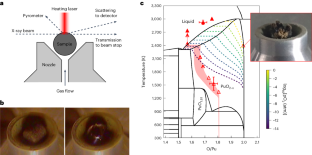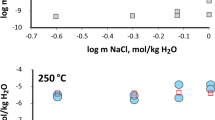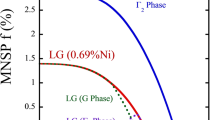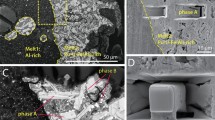Abstract
Advances in nuclear power reactors include the use of mixed oxide fuel, containing uranium and plutonium oxides. The high-temperature behaviour and structure of PuO2–x above 1,800 K remain largely unexplored, and these conditions must be considered for reactor design and planning for the mitigation of severe accidents. Here, we measure the atomic structure of PuO2–x through the melting transition up to 3,000 ± 50 K using X-ray scattering of aerodynamically levitated and laser-beam-heated samples, with O/Pu ranging from 1.57 to 1.76. Liquid structural models consistent with the X-ray data are developed using machine-learned interatomic potentials and density functional theory. Molten PuO1.76 contains some degree of covalent Pu–O bonding, signalled by the degeneracy of Pu 5f and O 2p orbitals. The liquid is isomorphous with molten CeO1.75, demonstrating the latter as a non-radioactive, non-toxic, structural surrogate when differences in the oxidation potentials of Pu and Ce are accounted for. These characterizations provide essential constraints for modelling pertinent to reactor safety design.
This is a preview of subscription content, access via your institution
Access options
Access Nature and 54 other Nature Portfolio journals
Get Nature+, our best-value online-access subscription
$29.99 / 30 days
cancel any time
Subscribe to this journal
Receive 12 print issues and online access
$259.00 per year
only $21.58 per issue
Buy this article
- Purchase on Springer Link
- Instant access to full article PDF
Prices may be subject to local taxes which are calculated during checkout




Similar content being viewed by others
Data availability
X-ray structure factor data for the PuO1.76 and CeO1.75 melts are provided in the Supplementary Information. All other relevant data are available from the corresponding author upon reasonable request.
References
Intergovernmental Panel on Climate Change. Climate Change 2022: Mitigation of Climate Change (2022).
Abram, T. & Ion, S. Generation-IV nuclear power: a review of the state of the science. Energy Policy 36, 4323–4330 (2008).
Chang, Y. I. et al. Conceptual design of a pilot-scale pyroprocessing facility. Nucl. Technol. 205, 708–726 (2019).
Carbajo, J. J., Yoder, G. L., Popov, S. G. & Ivanov, V. K. A review of the thermophysical properties of MOX and UO2 fuels. J. Nucl. Mater. 299, 181–198 (2001).
IAEA. Status and Advances in MOX Fuel Technology (2003).
Fouquet-Métivier, P. et al. Investigation of the solid/liquid phase transitions in the U–Pu–O system. Calphad 80, 102523 (2023).
Guéneau, C., Chartier, A., Fossati, P., Van Brutzel, L. & Martin, P. Thermodynamic and thermophysical properties of the actinide oxides. in Comprehensive Nuclear Materials 2nd edn 111–154 (Elsevier, 2020).
Vauchy, R., Joly, A. & Valot, C. Lattice thermal expansion of Pu1−yAmyO2–x plutonium–americium mixed oxides. J. Appl. Crystallogr. 50, 1782–1790 (2017).
Boivineau, J. C. Etude par rayons x du diagramme plutonium-oxygene de la temperature ambiante jusqu’a 1100°c. J. Nucl. Mater. 60, 31–38 (1976).
De Bruycker, F. et al. Reassessing the melting temperature of PuO2. Mater. Today 13, 52–55 (2010).
Ghosh, P. S. et al. Melting behavior of (Th,U)O2 and (Th,Pu)O2 mixed oxides. J. Nucl. Mater. 479, 112–122 (2016).
Cooper, M. W. D., Murphy, S. T., Rushton, M. J. D. & Grimes, R. W. Thermophysical properties and oxygen transport in the (Ux,Pu1–x)O2 lattice. J. Nucl. Mater. 461, 206–214 (2015).
Weber, J. K. R. et al. Aerodynamic levitator for in situ X-ray structure measurements on high temperature and molten nuclear fuel materials. Rev. Sci. Instrum. 87, 073902 (2016).
Besmann, T. M. & Lindemer, T. B. Chemical thermodynamic representations of <PuO2–x> and <U1–zPuzOw>. J. Nucl. Mater. 130, 489–504 (1985).
Benmore, C. J. X-ray diffraction from glass. in Modern Glass Characterization 241–270 (John Wiley & Sons, 2015).
McCormack, S. J., Tamalonis, A., Weber, R. J. K. & Kriven, W. M. Temperature gradients for thermophysical and thermochemical property measurements to 3,000 °C for an aerodynamically levitated spheroid. Rev. Sci. Instrum. 90, 15109 (2019).
Uchida, T., Sunaoshi, T., Konashi, K. & Kato, M. Thermal expansion of PuO2. J. Nucl. Mater. 452, 281–284 (2014).
Gardner, E. R., Markin, T. L. & Street, R. S. The plutonium-oxygen phase diagram. J. Inorg. Nucl. Chem. 27, 541–551 (1965).
Kato, M., Nakamura, H., Watanabe, M., Matsumoto, T. & Machida, M. Defect chemistry and basic properties of non-stoichiometric PuO2. Defect Diffus. Forum 375, 57–70 (2017).
Skinner, L. B. et al. Molten uranium dioxide structure and dynamics. Science 346, 984–987 (2014).
Alderman, O. L. G. et al. The structure of liquid UO2−x in reducing gas atmospheres. Appl. Phys. Lett. 110, 081904 (2017).
Soper, A. K. Empirical potential Monte Carlo simulation of fluid structure. Chem. Phys. 202, 295–306 (1996).
Neidig, M. L., Clark, D. L. & Martin, R. L. Covalency in f-element complexes. Coord. Chem. Rev. 257, 394–406 (2013).
Desgranges, L., Baldinozzi, G., Fischer, H. E. & Lander, G. H. Temperature-dependent anisotropy in the bond lengths of UO2 as a result of phonon-induced atomic correlations. J. Phys. Condens. Matter 35, 10LT01 (2023).
Wen, X. D., Martin, R. L., Henderson, T. M. & Scuseria, G. E. Density functional theory studies of the electronic structure of solid state actinide oxides. Chem. Rev. 113, 1063–1096 (2013).
Prodan, I. D., Scuseria, G. E. & Martin, R. L. Covalency in the actinide dioxides: systematic study of the electronic properties using screened hybrid density functional theory. Phys. Rev. B 76, 033101 (2007).
Yang, Y. & Zhang, P. Chemical bonds and vibrational properties of ordered (U, Np, Pu) mixed oxides. J. Appl. Phys. 113, 013501 (2013).
Andersson, D. A., Lezama, J., Uberuaga, B. P., Deo, C. & Conradson, S. D. Cooperativity among defect sites in AO2+x and A4O9 (A = U, Np, Pu): density functional calculations. Phys. Rev. B 79, 024110 (2009).
Vitova, T. et al. The role of the 5f valence orbitals of early actinides in chemical bonding. Nat. Commun. 8, 16053 (2017).
Bartók, A. P., Payne, M. C., Kondor, R. & Csányi, G. Gaussian approximation potentials: the accuracy of quantum mechanics, without the electrons. Phys. Rev. Lett. 104, 136403 (2010).
Sivaraman, G. et al. Experimentally driven automated machine-learned interatomic potential for a refractory oxide. Phys. Rev. Lett. 126, 156002 (2021).
Zinkevich, M., Djurovic, D. & Aldinger, F. Thermodynamic modelling of the cerium-oxygen system. Solid State Ion. 177, 989–1001 (2006).
Kim, H. S. et al. Applicability of CeO2 as a surrogate for PuO2 in a MOX fuel development. J. Nucl. Mater. 378, 98–104 (2008).
Kolman, D. G., Park, Y., Stan, M., Hanrahan, R. J. & Butt, D. P. An Assessment of the Validity of Cerium Oxide as a Surrogate for Plutonium Oxide Gallium Removal Studies. Report No. LA-UR-99-0491 (Los Alamos National Lab., 1999).
Darab, J. G. et al. Redox chemistry of plutonium and plutonium surrogates in vitrified nuclear wastes. J. Am. Ceram. Soc. 105, 6627–6639 (2022).
Cachia, J. N. et al. Enhancing cerium and plutonium solubility by reduction in borosilicate glass. J. Nucl. Mater. 352, 182–189 (2006).
Feuchter, H. et al. Influence of light and temperature on the extractability of cerium(iv) as a surrogate of plutonium(iv) and its effect on the simulation of an accidental fire in the PUREX process. ACS Omega 4, 12896–12904 (2019).
Lin, J., Cross, J. N., Diwu, J., Meredith, N. A. & Albrecht-Schmitt, T. E. Comparisons of plutonium, thorium, and cerium tellurite sulfates. Inorg. Chem. 52, 4277–4281 (2013).
Zamoryanskaya, M. V. & Burakov, B. E. Feasibility limits in using cerium as a surrogate for plutonium incorporation in zircon, zirconia and pyrochlore. MRS Proc. 663, 301 (2000).
Le Roux, S. & Jund, P. Ring statistics analysis of topological networks: new approach and application to amorphous GeS2 and SiO2 systems. Comput. Mater. Sci. 49, 70–83 (2010).
Sivaraman, G. et al. A combined machine learning and high-energy X-ray diffraction approach to understanding liquid and amorphous metal oxides. J. Phys. Soc. Jpn 91, 091009 (2022).
Minasian, S. G. et al. Quantitative evidence for lanthanide-oxygen orbital mixing in CeO2, PrO2, and TbO2. J. Am. Chem. Soc. 139, 18052–18064 (2017).
Guéneau, C. et al. Thermodynamic modelling of advanced oxide and carbide nuclear fuels: description of the U-Pu-O-C systems. J. Nucl. Mater. 419, 145–167 (2011).
Messier, D. R. Evaporation of hypostoichiometric plutonium dioxide from 2,070° to 2,380°K. J. Am. Ceram. Soc. 51, 710–713 (1968).
Krishnan, S., Weber, J. K. R., Schiffman, R. A., Nordine, P. C. & Reed, R. A. Refractive index of liquid aluminum oxide at 0.6328 μm. J. Am. Ceram. Soc. 74, 881–883 (1991).
Weber, J. K. R., Benmore, C. J., Jennings, G., Wilding, M. C. & Parise, J. B. Instrumentation for fast in-situ X-ray structure measurements on non-equilibrium liquids. Nucl. Instrum. Methods Phys. Res. A 624, 728–730 (2010).
Hammersley, A. P. FIT2D: a multi-purpose data reduction, analysis and visualization program. J. Appl. Crystallogr. 49, 646–652 (2016).
Skinner, L. B., Benmore, C. J. & Parise, J. B. Area detector corrections for high quality synchrotron X-ray structure factor measurements. Nucl. Instrum. Methods Phys. Res. A 662, 61–70 (2012).
Soper, A. K. & Barney, E. R. Extracting the pair distribution function from white-beam X-ray total scattering data. J. Appl. Crystallogr. 44, 714–726 (2011).
Faber, T. E. & Ziman, J. M. A theory of the electrical properties of liquid metals. Philos. Mag. A J. Theor. Exp. Appl. Phys. 11, 153–173 (1965).
Waasmaier, D. & Kirfel, A. New analytical scattering-factor functions for free atoms and ions. Acta Crystallogr. A51, 416–431 (1995).
Toby, B. H. & Von Dreele, R. B. GSAS-II: the genesis of a modern open-source all purpose crystallography software package. J. Appl. Crystallogr. 46, 544–549 (2013).
Skinner, L. B. et al. A time resolved high energy X-ray diffraction study of cooling liquid SiO2. Phys. Chem. Chem. Phys. 15, 8566–8572 (2013).
Soper, A. K. Inelasticity corrections for time-of-flight and fixed wavelength neutron diffraction experiments. Mol. Phys. 107, 1667–1684 (2009).
Pickup, D., Moss, R. & Newport, R. NXFit: a program for simultaneously fitting X-ray and neutron diffraction pair-distribution functions to provide optimized structural parameters. J. Appl. Crystallogr. 47, 1790–1796 (2014).
Wilke, S. K., Alderman, O. L. G., Benmore, C. J., Neuefeind, J. & Weber, R. Octahedral oxide glass network in ambient pressure neodymium titanate. Sci. Rep. 12, 8258 (2022).
Alderman, O. L. G., Skinner, L. B., Benmore, C. J., Tamalonis, A. & Weber, J. K. R. Structure of molten titanium dioxide. Phys. Rev. B 90, 094204 (2014).
Alderman, O. L. G., Benmore, C. J., Neuefeind, J., Tamalonis, A. & Weber, R. Molten barium titanate: a high-pressure liquid silicate analogue. J. Phys. Condens. Matter 31, 20LT01 (2019).
King, S. V. Ring configurations in a random network model of vitreous silica. Nature 213, 1112–1113 (1967).
Roux, S. Le. Atomes; https://atomes.ipcms.fr/ (2023).
Kresse, G. & Furthmüller, J. Efficient iterative schemes for ab initio total-energy calculations using a plane-wave basis set. Phys. Rev. B 54, 11169–11186 (1996).
Kresse, G. & Joubert, D. From ultrasoft pseudopotentials to the projector augmented-wave method. Phys. Rev. B 59, 1758–1775 (1999).
Perdew, J. P., Burke, K. & Ernzerhof, M. Generalized gradient approximation made simple. Phys. Rev. Lett. 77, 3865–3868 (1996).
Chen, J.-L. & Kaltsoyannis, N. DFT + U study of uranium dioxide and plutonium dioxide with occupation matrix control. J. Phys. Chem. C 126, 11426–11435 (2022).
Liechtenstein, A. I., Anisimov, V. I. & Zaanen, J. Density-functional theory and strong interactions: orbital ordering in Mott-Hubbard insulators. Phys. Rev. B 52, R5467–R5470 (1995).
Wang, H. & Konashi, K. LDA+U study of Pu and PuO2 on ground state with spin–orbital coupling. J. Alloy. Compd. 533, 53–57 (2012).
Cooper, M. W. D. et al. Development of Xe and Kr empirical potentials for CeO2, ThO2, UO2 and PuO2, combining DFT with high temperature MD. J. Phys. Condens. Matter 28, 405401 (2016).
Grimme, S., Antony, J., Ehrlich, S. & Krieg, H. A consistent and accurate ab initio parametrization of density functional dispersion correction (DFT-D) for the 94 elements H-Pu. J. Chem. Phys. 132, 154104 (2010).
Grimme, S., Ehrlich, S. & Goerigk, L. Effect of the damping function in dispersion corrected density functional theory. J. Comput. Chem. 32, 1456–1465 (2011).
Bartók, A. P., Kondor, R. & Csányi, G. On representing chemical environments. Phys. Rev. B 87, 184115 (2013).
Deringer, V. L. & Csányi, G. Machine learning based interatomic potential for amorphous carbon. Phys. Rev. B 95, 94203 (2017).
Sivaraman, G. et al. Machine-learned interatomic potentials by active learning: amorphous and liquid hafnium dioxide. npj Comput. Mater. 6, 104 (2020).
Sivaraman, G. et al. Automated development of molten salt machine learning potentials: application to LiCl. J. Phys. Chem. Lett. 12, 4278–4285 (2021).
Guo, J. et al. Composition-transferable machine learning potential for LiCl-KCl molten salts validated by high-energy X-ray diffraction. Phys. Rev. B 106, 14209 (2022).
Guo, J. et al. AL4GAP: active learning workflow for generating DFT-SCAN accurate machine-learning potentials for combinatorial molten salt mixtures. J. Chem. Phys. 159, 24802 (2023).
Cooper, M. W. D., Rushton, M. J. D. & Grimes, R. W. A many-body potential approach to modelling the thermomechanical properties of actinide oxides. J. Phys. Condens. Matter 26, 105401 (2014).
Cooper, M. W. D., Murphy, S. T., Fossati, P. C. M., Rushton, M. J. D. & Grimes, R. W. Thermophysical and anion diffusion properties of (Ux,Th1–x)O2. Proc. R. Soc. A Math. Phys. Eng. Sci. 470, 20140427 (2014).
Plimpton, S. Fast parallel algorithms for short-range molecular dynamics. J. Comput. Phys. 117, 1–19 (1995).
Csányi, G. et al. Expressive programming for computational physics in Fortran 95+. IoP Comput. Phys. Newsl. 1 (2007).
Nosé, S. A unified formulation of the constant temperature molecular dynamics methods. J. Chem. Phys. 81, 511–519 (1984).
Hoover, W. G. Canonical dynamics: equilibrium phase-space distributions. Phys. Rev. A 31, 1695–1697 (1985).
Acknowledgements
This work was supported by the US Department of Energy (DOE) through grants DE-SC0018601 and DE-SC0015241 and the Argonne Laboratory Directed Research and Development program. X-ray diffraction measurements were made at Sector 6-ID-D of the Advanced Photon Source, a US DOE Office of Science User Facility, operated by Argonne National Laboratory under contract no. DE-AC02-06CH11357. Computational modeling resources were provided by Bebop, a high-performance computing cluster operated by the Laboratory Computing Resource Center at Argonne National Laboratory. We gratefully acknowledge J. Vacca, L. Soderholm, W. VanWingeren and E. Schmidt for technical advice and safety management contributions that enabled the X-ray measurements; M. Schvaneveldt for assembling the sample chamber; A. Hebden for sample chamber design considerations; and S. Salbeck, Hadco Tool LLC, for advice and fabrication of the sample handling, nozzle housing and sample die components.
Author information
Authors and Affiliations
Contributions
C.J.B., O.L.G.A., M.A.W. and R.W. conceived the idea for X-ray diffraction measurements and developed the sample chamber with A.T. O.L.G.A. wrote the proposal for X-ray beamtime. S.K.W., C.J.B. and R.W. conducted the X-ray measurements. S.K.W. analysed the X-ray data and performed the EPSR measurements with guidance from C.J.B., O.L.G.A. and R.W. G.S. developed the GAP from DFT calculations and performed the MD simulations, under the guidance of D.A.A. M.D.R. and K.L.H. prepared the PuO2 samples and facilitated radioactive-sample handling under the guidance of M.A.W. S.K.W. prepared the manuscript draft, with revisions contributed by all authors.
Corresponding author
Ethics declarations
Competing interests
The authors declare no competing interests.
Peer review
Peer review information
Nature Materials thanks Gerry Lander, Dario Manara and Romain Vauchy for their contribution to the peer review of this work.
Additional information
Publisher’s note Springer Nature remains neutral with regard to jurisdictional claims in published maps and institutional affiliations.
Extended data
Extended Data Fig. 1 Fitting of Gaussian distributions to the total PDF for molten PuO1.76.
a, Fitting a single PuO distribution to the leading edge of the first peak, and a single PuPu distribution to the leading edge of the second peak. b, Optimized peak fitting for all pair correlations, guided by the bond distances and coordinations anticipated from f-PuO2 and α-Pu2O3 crystal structures.
Extended Data Fig. 2 Ce-O phase diagram.
Colored markers show oxygen gas partial pressure (pO2) isobars32. The redox trajectory for a sample heated under pure O2 is shaded in pink.
Extended Data Fig. 3 Faber-Ziman X-ray weighting factors.
a, PuO1.76. b, CeO1.75. From Eq. 2.
Extended Data Fig. 4 Examples of sample temperature during levitation and laser beam heating.
a, Emissivity-corrected temperature measurements (10 Hz acquisition) from the optical pyrometer for PuO2−x solid heated under 5% CO (Ar balance). Laser power was increased incrementally, interspersed with X-ray diffraction measurements taken while the sample was held isothermally. b, Zoomed-in view of a single isotherm from (a). For the time period 364–416 s, the temperature mean was 2140 K with a standard deviation of 71 K. c, Temperature of molten PuO1.57 during a different heating run than (a-b). X-ray measurements were analyzed for the time period 105–110 s, which had a temperature mean of 2730 K and a standard deviation of 2 K.
Extended Data Fig. 5 X-ray diffraction and Rietveld refinements for selected crystalline samples.
a, Initial Pu-O material before heating. b, Pure f-PuO2 after heating under O2. The observed X-ray diffraction patterns (green curves) and calculated Rietveld refinement models (orange curves) are compared against the Bragg reflections for f-PuO2, α-Pu2O3, and β-Pu2O3 (blue, teal, and red vertical ticks). The black curves show the differences between the X-ray data and refinement models, divided by the estimated standard uncertainties.
Extended Data Fig. 6 Fitting of a Lorentzian function to the structure factor’s first principal peak, for molten PuO1.76.
The fit53 includes the Lorentzian contribution mirrored across Q = 0 Å−1 and is constrained15 to \(S\left(0\right)=1-\left\langle\; {f(0)}^{2}\right\rangle /{\left\langle\; f(0)\right\rangle }^{2}={-}1.113\). The X-ray diffraction data were extrapolated to Q = 0 using this Lorentzian fit, prior to the Fourier transform to obtain the PDFs (Eqs. 3, 4).
Extended Data Fig. 7 Effect of top hat convolution on X-ray data.
Comparison of the (a) X-ray structure factor and (b) total PDF for molten PuO1.76, processed with and without the top hat convolution54 in GudrunX. For this comparison, Qmax = 11.9 Å−1 was used for both structure factors to avoid large truncation oscillations in the PDF without top hat.
Supplementary information
Supplementary Information
Supplementary Figs. 1–3, Tables 1–4 and discussion.
Supplementary Data 1
X-ray total structure factor for molten PuO1.76.
Supplementary Data 2
X-ray total structure factor for molten CeO1.75.
Rights and permissions
Springer Nature or its licensor (e.g. a society or other partner) holds exclusive rights to this article under a publishing agreement with the author(s) or other rightsholder(s); author self-archiving of the accepted manuscript version of this article is solely governed by the terms of such publishing agreement and applicable law.
About this article
Cite this article
Wilke, S.K., Benmore, C.J., Alderman, O.L.G. et al. Plutonium oxide melt structure and covalency. Nat. Mater. (2024). https://doi.org/10.1038/s41563-024-01883-3
Received:
Accepted:
Published:
DOI: https://doi.org/10.1038/s41563-024-01883-3



